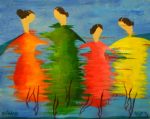“Rikud” by Givon (photo by Olga Livshin)
The current exhibit at the Zack Gallery – the Festival Ha’Rikud group show, called Israeli Music through the Years – is a fundraiser. Every painting on display has a silent auction sheet beside it, and people can bid on the pieces they like. The bidding closes on June 1, with all the proceeds going to the gallery.
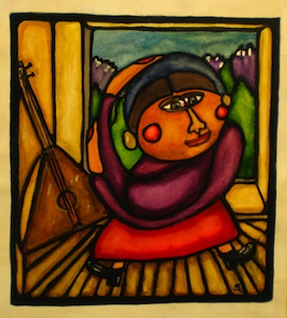
Opening night on May 15 was a festive affair. Almost all of the 60 participating artists came to mingle and cheer one another on.
“The gallery offered all the artists boards of a universal size to paint on,” explained gallery director Linda Lando. “I sent the boards to the artists about three months ago to give them plenty of time. Every painting in the show is the exact same size, while the selection of the artists is eclectic. Some are professional artists I’ve had on my radar for years. Others are JCC members or their friends who learned about the show and applied. One entire wall of the show is dedicated to paintings created by Louis Brier’s residents attending art lessons. For many, it is their first show. Some never even painted before. It’s very brave of them to put their art out for everyone to see and judge.”
The paintings are as different as the artists themselves, although the theme is the same: music in one guise or another. Some artists lean towards Jewish mythology, like Penelope Harris’s mixed media “Miriam and her Sisters.” Three women dance in the painting, all wearing timeless clothing in soft colours.
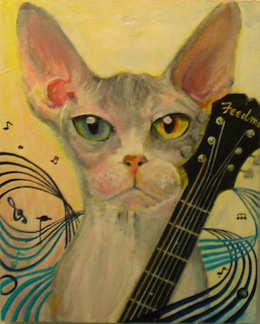
Dancing seems to be a popular subject. In the artist Givon’s painting “Rikud,” four stylized women dance, their colours and shapes flowing into one another, while “Babushka,” by Carl Rothschild, dances alone, exuding humour and sharp lines; her balalaika leans on a wall beside the dancer, adding a Russian flavour to the painting.
Nini Rostoker-Shipman’s “Let’s Dance” is all about shoes. In the subdued brownish image, a couple dozen pairs of worn shoes – sandals, slippers and flats – lie docilely side by side, like a collection. Only one pair of shoes stands out. These are high-heels with sparkly buckles – real shoes glued to the image. Perhaps some fashionable woman from the artist’s family danced in those shoes long ago? The shoes look impertinent enough to enjoy dancing.
Other works explore music’s players, the musicians, as well as musical notations or instruments. In this stream, Maggie Farrar’s portrait of Leonard Cohen attracts attention. The showman’s ubiquitous hat sits rakishly on his head, and the names of his famous songs scroll across the canvas.
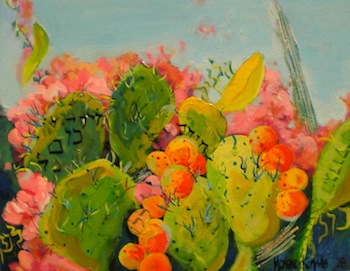
Below the portrait of Cohen hangs a piece by Wing Yee Wong called “Legacy.” The painting is popular with the auction bidders. It depicts an Abyssinian cat with its disproportionately big ears and haughty eyes, one yellow, another green. The cat is clutching a guitar and staring at viewers with contempt. There is an inscription on the guitar handle, demanding, “Feed me.” It’s hard not to smile while looking at it.
Musical instruments are also featured in “Where are the Ladies?” by Marion Eisman. In the mischievous painting, an all-male klezmer ensemble jams a merry tune on a shtetl street.
Another orchestra, in a piece by Alan Woolf using a pastel palette, is much more serious. These musicians perform a classical concert in the ruins of an ancient amphitheatre. The musicians’ tiny, delicate figures look like pencil sketches on the background of an azure Israeli sky.
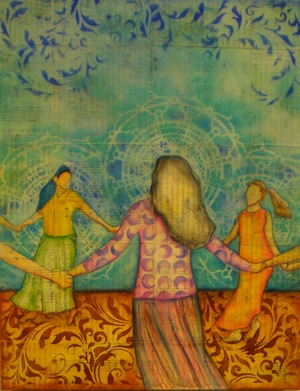
In contrast, Iza Radinsky’s instruments play by themselves. No people populate her bold painting, just bright colours and ringing notes.
Bright colours also characterize Marlene Konyves’ “Sabras Rejoicing” – a bunch of gleeful blooming cacti – and Jocelyne Halle’s collage, which incorporates several of her Israeli photographs. “It is my first attempt at collage,” said the well-known photographer, who has exhibited her work at the Zack before.
And then there are abstracts. A rhapsody in green in Claire Cohen’s painting hints at melodic skeins and vague instrumental shapes. Sidi Schaffer’s “Eli, Eli,” with its butterflies flitting across the joyful blue ether, is infused with faint sadness – the title of the painting is the same as the song that inspired it.
“I love that song,” said Schaffer. “It is well known in Israel. It was written by Hannah Szenes, a Hungarian Jew. She immigrated to Palestine and became a paratrooper during the Second World War. She was killed by the Nazis when she was only 23, but her poetry is famous in Israel.”
It is impossible to mention all 60 artists who are participating in this show, but it can be said that all of the work on display demonstrates a love of art and music.
Olga Livshin is a Vancouver freelance writer. She can be reached at [email protected].

